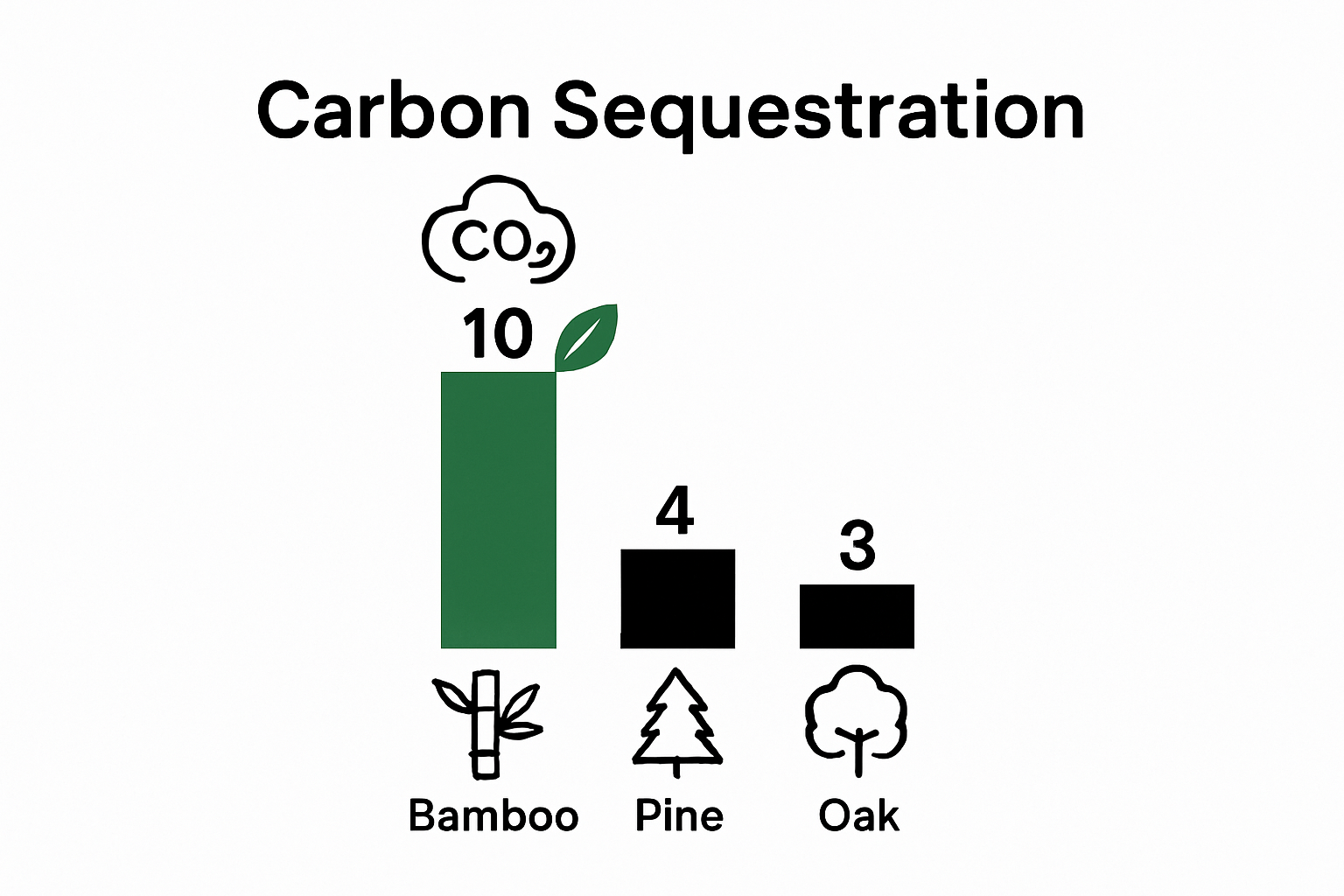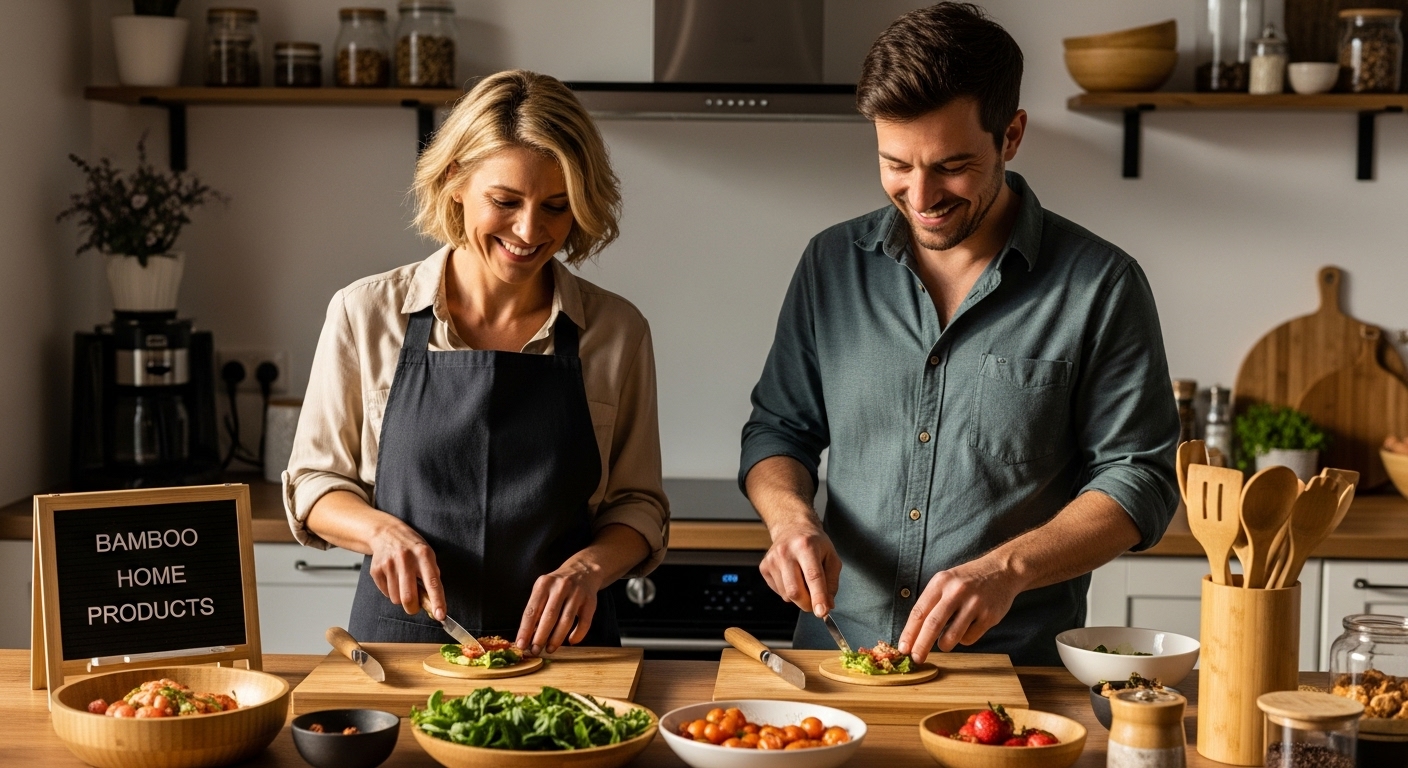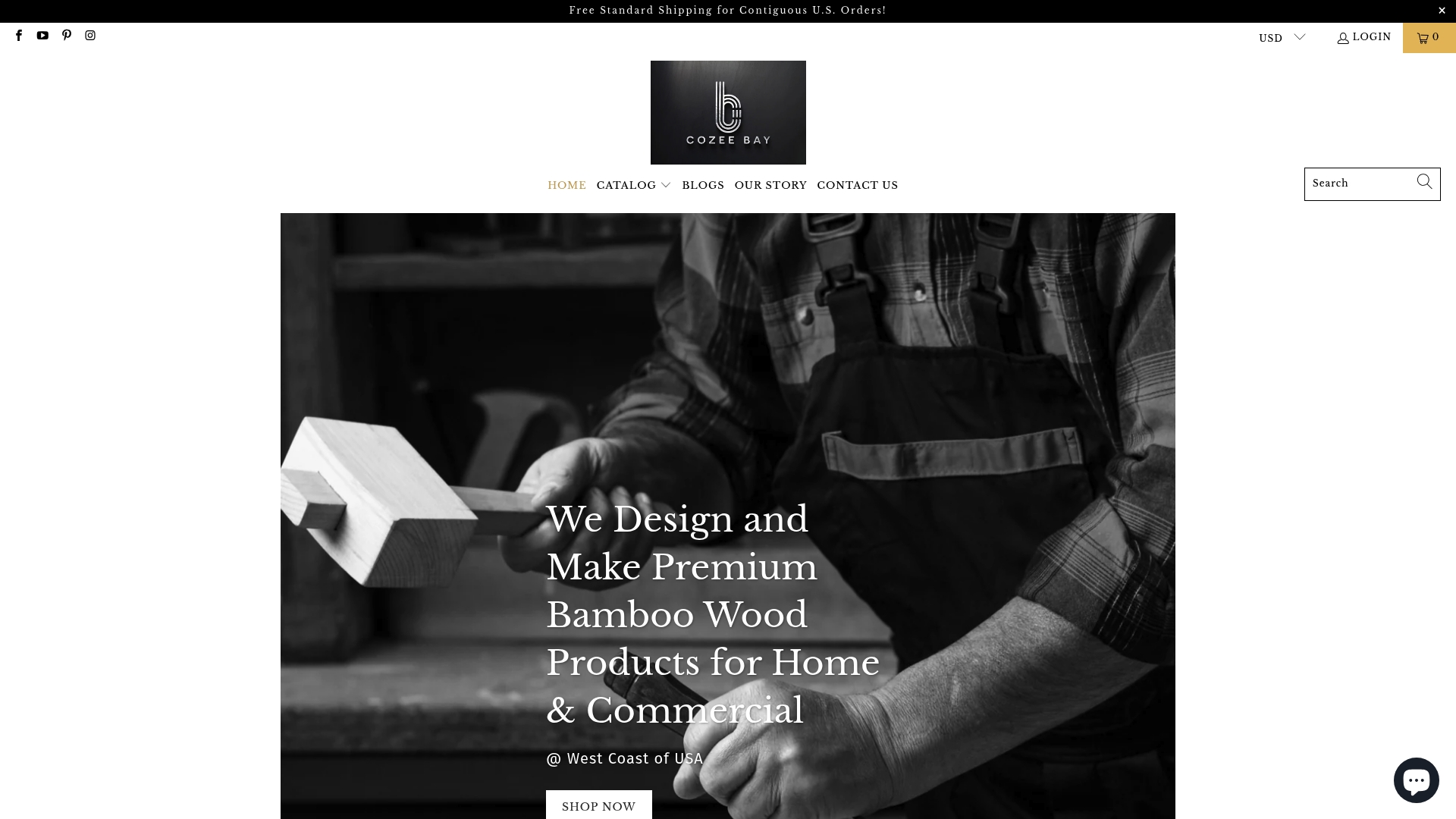Your Cart is Empty
Free Standard Shipping for Contiguous U.S. Orders!
Free Standard Shipping for Contiguous U.S. Orders!
Catalog

Understanding the Benefits of Bamboo for Homes
September 27, 2025 8 min read
Bamboo is popping up everywhere in home design and not just because it looks good. Some species can grow up to 36 inches in a single day and that makes them the fastest-growing plants on Earth. People think of bamboo as just another eco-friendly alternative to wood but it is actually a powerhouse that handles everything from climate change to modern architecture with surprising strength and style.
Table of Contents
- What Is Bamboo And Why Is It Valuable For Homes?
- Environmental Impact: The Sustainability Of Bamboo
- Bamboo’s Unique Properties: Strength And Durability Explained
- Practical Applications: How Bamboo Enhances Home Design
- The Future Of Bamboo In Home Construction And Decor
Quick Summary
| Takeaway | Explanation |
|---|---|
| Bamboo is a fast-growing grass. | Bamboo can grow up to 36 inches a day, making it a highly renewable resource. |
| Bamboo has natural antimicrobial properties. | This helps prevent bacterial growth, making it ideal for kitchens and bathrooms. |
| Bamboo absorbs more carbon than trees. | A hectare of bamboo can sequester 15 tons of carbon dioxide per year, aiding climate change efforts. |
| Bamboo requires minimal resources for cultivation. | It grows quickly without the need for replanting or excessive land, making it eco-friendly. |
| Bamboo products combine strength and flexibility. | Its unique structure allows for durable and innovative designs in furniture and decor. |
What is Bamboo and Why is it Valuable for Homes?
Bamboo represents a remarkable natural material that has been transforming modern home design and sustainability practices. Unlike traditional wood, bamboo is actually a fast-growing grass species that offers extraordinary versatility and ecological benefits for residential spaces. Learn more about bamboo’s unique properties and discover why it has become a preferred choice for environmentally conscious homeowners.
The Natural Composition of Bamboo
At its core, bamboo is a unique plant characterized by remarkable growth patterns and structural integrity. Botanically classified as a grass, bamboo can grow incredibly quickly compared to traditional hardwood trees. Some bamboo species can grow up to 36 inches in a single day, making it one of the fastest-growing plants on the planet. This rapid regeneration process contributes significantly to its sustainability and ecological value.
Key characteristics that make bamboo extraordinary include:
- Incredibly fast growth rate
- Strong cellular structure
- Natural resistance to moisture and pests
- Minimal environmental impact during cultivation
Environmental and Practical Benefits for Homes
Bamboo offers homeowners a comprehensive solution that combines aesthetic appeal with functional advantages. Research from the World Wildlife Fund highlights bamboo’s potential as a sustainable resource that provides multiple ecological benefits. When utilized in home design, bamboo products contribute to reduced carbon footprint while delivering exceptional durability and performance.
The material’s inherent properties make it an ideal choice for various home applications. Its natural antimicrobial qualities help prevent bacterial growth, while its lightweight yet strong composition allows for innovative design solutions across furniture, flooring, kitchen accessories, and decorative elements. Homeowners seeking eco-friendly alternatives increasingly recognize bamboo as a smart, responsible material that does not compromise on quality or aesthetic appeal.
To help clarify the major environmental and practical benefits of using bamboo in home design, here is a side-by-side comparison of its advantages versus traditional wood.
| Benefit | Bamboo | Traditional Wood |
|---|---|---|
| Growth Rate | Up to 36 inches per day | Several years to decades |
| Carbon Sequestration | Absorbs 15 tons CO2 per hectare per year | Lower per hectare absorption |
| Resource Requirements | Minimal water and land needed | Often higher resource needs |
| Replanting Needed After Harvest | No, regrows from same root system | Yes, must be replanted |
| Antimicrobial Properties | Naturally antimicrobial | Varies, often requires treatment |
| Durability | High, resistant to moisture and pests | Varies, susceptible to rot/pests |
| Time to Maturity | 3-5 years | 20-120 years |
Environmental Impact: The Sustainability of Bamboo
Bamboo emerges as a powerful solution to environmental challenges, offering extraordinary sustainability benefits that extend far beyond traditional materials. Discover the compelling reasons to choose bamboo for eco-friendly living and understand how this remarkable plant is transforming our approach to environmental conservation.
Carbon Sequestration and Climate Mitigation
Compared to traditional forests, bamboo demonstrates remarkable capabilities in carbon absorption and environmental restoration. Research from the International Network for Bamboo and Rattan indicates that bamboo forests can sequester significantly more carbon dioxide than equivalent woodland areas. A single hectare of bamboo can absorb up to 15 tons of carbon per year, making it an exceptional tool in combating climate change.

Key environmental advantages of bamboo include:
- Rapid carbon dioxide absorption
- Minimal land requirement for cultivation
- Low water consumption compared to timber farming
- Natural soil erosion prevention
Regenerative Agricultural Practices
Unlike traditional timber harvesting, bamboo represents a regenerative agricultural model that does not require replanting after harvest. When bamboo stalks are cut, the root system remains intact, allowing immediate regrowth without additional planting or significant soil disruption. This unique characteristic ensures continuous plant reproduction and minimizes agricultural intervention.
The plant’s extraordinary growth rate and minimal resource requirements make it an ideal sustainable material. Bamboo can grow up to 3 feet in 24 hours, completing full maturation cycles in just 3-5 years compared to traditional hardwood trees that require 20-120 years. This rapid regeneration translates directly into reduced environmental impact and increased resource efficiency for industries seeking sustainable alternatives.
Bamboo’s Unique Properties: Strength and Durability Explained
Bamboo transcends traditional material expectations, offering a combination of strength, flexibility, and resilience that makes it extraordinary for home applications. Learn more about why bamboo home products are revolutionizing sustainable living and discover the scientific principles behind its remarkable performance.
Structural Composition and Mechanical Strength
Research from Materials Science journals reveals that bamboo’s cellular structure provides exceptional mechanical properties. Its unique microstructure features dense, interconnected fibers that deliver remarkable tensile strength comparable to and often surpassing traditional steel. The plant’s natural cylindrical design creates an intrinsic architectural strength that distributes weight and stress evenly across its structure.
Key structural characteristics of bamboo include:
- High strength-to-weight ratio
- Natural flexibility under stress
- Uniform fiber distribution
- Resistance to compression and tension
Natural Durability and Resilience
Unlike many traditional materials, bamboo possesses inherent protective mechanisms that enhance its longevity and performance. The plant contains natural silica and lignin compounds that provide robust resistance against moisture, fungal growth, and insect damage. These biological defense mechanisms translate into exceptional durability for home products, reducing maintenance requirements and extending the material’s functional lifespan.
Bamboo’s molecular structure allows it to withstand significant environmental variations without compromising its structural integrity. Its ability to contract and expand with temperature changes prevents cracking and warping, making it an ideal material for diverse home environments. Homeowners can expect bamboo products to maintain their aesthetic appeal and functional performance across various conditions, from humid kitchens to dry living spaces.
For a quick overview, the following table summarizes the distinctive properties that make bamboo a unique and superior material for various home applications.
| Property | Description |
|---|---|
| Strength-to-Weight Ratio | High, comparable to steel |
| Flexibility | Naturally flexible, resists cracking or warping |
| Antimicrobial Resistance | Resists bacteria, ideal for kitchens/bathrooms |
| Moisture/Damage Resistance | Contains silica/lignin to prevent fungal and insect attack |
| Thermal Regulation | Helps maintain comfortable indoor temperature |
| Sound Absorption | Dampens noise, creates quieter spaces |
| Maintenance Needs | Low, requires minimal upkeep due to natural resilience |

Practical Applications: How Bamboo Enhances Home Design
Bamboo transforms home design by offering versatile solutions that blend aesthetic appeal with exceptional functionality. Explore the top uses for bamboo in modern homes and discover how this remarkable material can revolutionize your living spaces.
Innovative Interior Design Solutions
Research from Interior Design Magazine highlights bamboo’s extraordinary potential in creating sophisticated and sustainable home environments. Unlike traditional materials, bamboo offers designers unprecedented flexibility in texture, color, and form. Its natural variations allow for seamless integration across multiple design styles, from minimalist modern to rustic organic aesthetics.
Key design applications of bamboo include:
- Flooring with unique grain patterns
- Lightweight and elegant furniture
- Decorative wall paneling
- Textural accent pieces
Functional Home Spaces and Performance
Beyond aesthetic considerations, bamboo delivers exceptional performance across various home applications. Its natural antimicrobial properties make it ideal for high-moisture areas like kitchens and bathrooms, where traditional materials might deteriorate. The material’s inherent strength allows for creating slim, elegant designs without compromising structural integrity.
Homeowners appreciate bamboo’s ability to adapt to different environmental conditions. Its thermal regulation properties help maintain comfortable indoor temperatures, while its sound absorption capabilities contribute to creating peaceful living spaces. From kitchen utensils to bathroom accessories, bamboo provides a combination of beauty, durability, and practical functionality that traditional materials struggle to match.
The Future of Bamboo in Home Construction and Decor
The evolution of bamboo in home design represents a transformative approach to sustainable architecture and interior styling. Discover innovative ways to incorporate bamboo decor into your living spaces and explore the cutting-edge potential of this remarkable material.
Technological Advancements in Bamboo Engineering
Research from the International Network for Bamboo and Rattan reveals groundbreaking developments in engineered bamboo technologies. Scientists and architects are now creating advanced composite materials that dramatically expand bamboo’s structural capabilities. These innovations transform bamboo from a traditional craft material into a sophisticated architectural solution capable of meeting modern construction standards.
Key technological breakthroughs include:
- Laminated bamboo lumber for structural applications
- High-performance bamboo composites
- Advanced treatment techniques for enhanced durability
- Precision engineering for architectural precision
Emerging Design and Sustainability Trends
The future of home design increasingly centers on materials that deliver both aesthetic excellence and environmental responsibility. Bamboo stands at the forefront of this movement, offering architects and designers a versatile medium that meets stringent sustainability requirements. Its ability to provide sophisticated design solutions while maintaining minimal environmental impact makes it an ideal material for forward-thinking home construction.
Architectural trends are showing a significant shift towards integrating bamboo in complex structural applications. From load-bearing walls to intricate interior design elements, bamboo is proving itself as more than just a decorative material. Innovative techniques now allow for creating entire building systems that leverage bamboo’s natural strength, flexibility, and renewable characteristics, signaling a profound transformation in how we conceptualize sustainable home design.
Bring the Benefits of Bamboo Into Your Home with Cozee Bay
You have just learned how bamboo offers unmatched strength, sustainability, and style for modern homes. Maybe you’re searching for ways to make your home more eco-friendly without giving up beauty or durability. Or perhaps you want everyday products that actually last and help minimize your environmental impact. The article highlighted how bamboo’s regenerative growth, antimicrobial properties, and beautiful finishes set it apart from traditional materials. Now, you can turn these insights into action and create a healthier, more inspiring space for your family.
Looking for a direct upgrade? Explore our Bamboo Paper Towel Dispenser Collection for the perfect blend of natural elegance and functionality. Each dispenser is handcrafted to deliver the sustainable, stylish touch your kitchen, bathroom, or workspace deserves.

Ready to transform your home and make a positive impact? Shop with confidence at Cozee Bay for premium bamboo solutions that look beautiful and perform beautifully. Choose eco-friendly excellence today while supplies last.
Frequently Asked Questions
What are the environmental benefits of using bamboo in home design?
Bamboo offers significant environmental benefits, including rapid carbon dioxide absorption, low land and water requirements for cultivation, and natural soil erosion prevention. This makes it a sustainable alternative to traditional timber.
How does bamboo compare to traditional hardwood in terms of strength and durability?
Bamboo has a high strength-to-weight ratio, often surpassing traditional hardwood in tensile strength. Its natural compounds provide resistance against moisture, fungi, and insects, translating into exceptional durability and reduced maintenance needs.
Can bamboo be used in high-moisture areas of the home, like kitchens and bathrooms?
Yes, bamboo’s natural antimicrobial properties make it ideal for high-moisture areas. It performs well in environments that may otherwise cause traditional materials to deteriorate, ensuring longevity and maintaining aesthetic appeal.
What are the practical applications of bamboo in home design?
Bamboo can be used for flooring, furniture, decorative wall paneling, and kitchen utensils, among other applications. Its versatility allows for innovative designs that enhance both aesthetic appeal and functionality in various home settings.
Recommended
Leave a comment
Comments will be approved before showing up.
Subscribe
Sign up to get the latest on sales, new releases and more …

